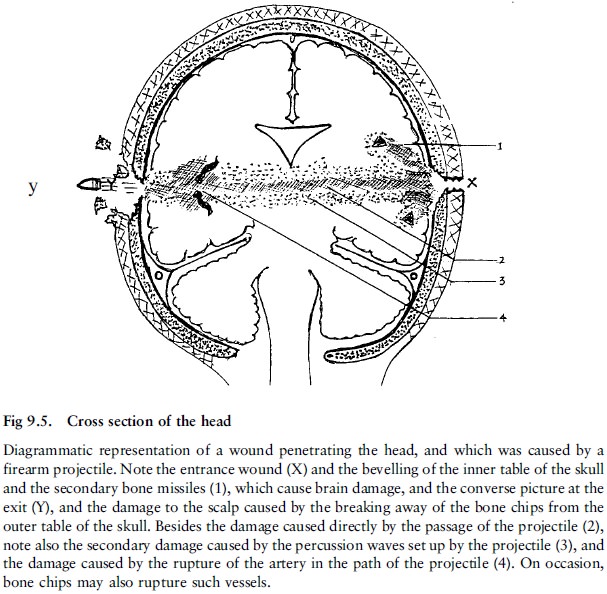Chapter: Forensic Medicine: Firearm injuries
Cutaneous gunshot exit wounds caused by rifled firearms
Cutaneous gunshot exit wounds caused by rifled
firearms
Introduction
These are produced by a stretching force applied
to the skin from its undersurface with perforation of the dermis and epidermis
when their limits of elasticity are exceeded. The surface defects vary widely
in shape and configuration and may be stellate, cruciate, round, elliptical,
crescentic or linear cutaneous-lacerations. The greater the missile's velocity
when it exits, the larger and more jagged the exit wound. Skin edges are often
everted (inside-out) and shreds of contused (bruised), haemorrhagic
subcutaneous fat may extrude through the defect. Characteristic features of
dermal entrance wounds such as the marginal abrasion ring, soiling and burning,
are absent from exit wounds, with the exception of those located over a part of
the body which lies beneath or is pressed against a firm surface such as a
leather belt, a wall or the ground. In these cases a marginal abrasion ring may
surround the exit wound.

Exit wounds are usually larger than entrance
wounds, provided the latter had not been affected by expanding explosion gases.
Two factors, acting either individually or together, are usually responsible
for the greater size of exit wounds. The first factor is tumbling of the
missile, which increases the chances of it leaving the body with an oblique
surface presented at the striking area. The missile is thus turned sideways,
and does not move forward head first. The second factor is bullet deformation
due to it striking some hard object such as bone, which causes consequent
flattening of and an increase in missile diameter, a type of change especially
common in soft-nosed and hollow-nosed projectiles.
When the examiner is confronted with a single
entrance wound and multiple exits, the possibility of bullet and/or bone
fragmentation should be considered. If the shot was fired from beyond the range
at which tattooing would occur it can be difficult to differentiate between an
entrance and exit wound. If the projectile passes through bone, and
particularly the skull, the direction can be readily determined, since the
entrance into the bone will be sharply cut and about the same diameter as the
projectile. On the inner table the bone will exhibit a bevelling (sloping)
effect and the defect in the bone will be generally larger than that at the
entrance. The bone breaking away from the inner table will produce secondary
missiles which may cause more extensive tissue damage than the missile itself.
As the projectile leaves the skull the converse will apply, that is the wound
on the outer table will be bevelled.
Case study
A patient was found to have a .22 bullet lodged
in the occipital portion of his skull immediately below the entrance wound in
the scalp. He died later that night. At post-mortem examination it was found
that a small chip of bone from the inner table of the skull had pierced the
dural venous sinus, which had given rise to a large subdural haemorrhage which,
in turn had caused the victim's demise. The small bone fragment was missed upon
initial examination of the X-ray plate.
Related Topics